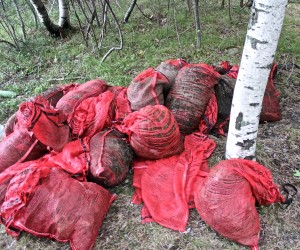Maine Lakefront Property Owners Appreciate Songo River Success Story
Out and About for the Sebago Lakes Region of Maine Sept. 3-9
September 3, 2015Out and About for the Bangor Lakes Region of Maine Sept. 10-16
September 10, 2015Maine Lakefront Property Owners Appreciate Songo River Success Story
Lakes Environmental Association Nearly Eradicates Milfoil from the Songo River in Casco, Maine
text and photos by Leigh Macmillen Hayes
The year was 2004 and the Songo River that connects Sebago Lake to Brandy Pond and Long Lake was so infested with the aquatic invasive variable-leaf milfoil (Myriophyllum heterophyllum) that people thought it was crazy for Lakes Environmental Association to take on the task of eradicating it. If you know LEA’s Executive Director Peter Lowell, however, you know he welcomes a challenge.
Milfoil covered sixty percent of the river. In some coves and straight-aways there were enormous infestations. Lowell describes it as looking like guts in the water.

Variable-leaf milfoil has a thick, reddish stem with whorls of finely-divided leaves. The roots are thin and fragile—think angel hair pasta.
This milfoil prefers to grow in relatively calm and shallow (less than 20 feet) waters. Typically, it grows straight up, but in shallower water the stem turns and the plant begins to grow horizontally, thus creating a thick mat.
Its main form of reproduction is by fragmentation. Broken shoots are carried downstream by water currents, boats and waterfowl. It only takes a small piece of the plant to begin a new population.
Milfoil can negatively impact native species, recreation and even property values around infected waterbodies.
Traveling along the river this past summer with an LEA employee, I learned that there’s hardly a plant visible.
Our tour included visiting sites where the infestation had been heaviest, such as behind the sandbar at Sebago Lake State Park, by the rope swing along the river’s edge and at the Songo Lock basin.
The milfoil crew consists of six to eight strapping young men. This is a skill-based job—learning to identify the plant, lay the barriers, scuba dive, etc. The learning curve is huge, so he appreciates that the team members return year after year.
Crew leader Christian Oren has been with the team for nine years, his brother Tyler for eight. Derrek Douglass and Thomas Chagrasulis are four-year members. Sullivan Tidd and Lucien Sulloway joined the crew two years ago.
Their work base is the SS Libra, a pontoon boat purchased with grant money from the Libra Foundation. The boat houses a Diver Assisted Suction Harvester.
The DASH provides an efficient method to remove milfoil from the water. It has a suction hose that divers carry into large infestations. While underwater, they harvest milfoil by the roots and feed the material into the hose.
Aboard the Libra, roots, stems and leaves are then processed in its sluiceway, which bags the plant material. This harvesting technique allows divers to remove large quantities while maintaining underwater visibility.
For smaller infestations, they remove plants by hand, placing the plant material in dive bags. Once harvested, the milfoil gets composted away from the water.
In some infested areas, the crew also uses benthic barriers to manage the invasive plant. To do this, they need permits from Maine’s Department of Environmental Protection.
Over the years, they tried a variety of materials including large tarps, shrink wrap and biodegradable burlap, which they laid on the sediment and secured with stakes.

The benthic mats restrict sunlight from reaching the bottom; the absence of light on the substrate halts the growth of the plants—both native and invasive. This is a chemical-free form of treating the plants and is reusable.
The barriers are removed after they’ve done their job of smothering milfoil, thus allowing native plants to regrow from the seedbank in the sediment.
On our journey, we stop to chat with the crew. Douglass of Bridgton, recalls his first day on the job, “It was like a sea of milfoil. There were giant patches. It was really thick and you couldn’t swim.”
Throughout the 2015 season, they surveyed areas where they had previously removed plants. The program has been highly successful and they often find either no invasive plants or only a few growing where they were once incredibly dense.
Oren says, “We see a lot more native plants where there was milfoil. It’s now the correct habitat for them and huge schools of fish swim through.”

It used to be that they harvested thirty to fifty bags worth of milfoil each day. And every two days, they made a trip to the compost pile. This year, their combined finds didn’t fill one bag a day and they waited two weeks before dumping the weeds on the pile.
Lowell is extremely impressed with the work that has been completed and recognizes that all the money invested into this program has paid off. He never thought it would be as clean as it is today. “We know now that we can control it,” he says.
John McPhedran, Maine DEP’s Invasive unit leader, is equally impressed. He encouraged Lowell to remove the milfoil signs along the river. “Given LEA’s phenomenal success of controlling the milfoil in this river corridor – there are no longer dense patches of variable milfoil along the river – Peter agrees with removal of the milfoil-related signs.” He also suggested that the yellow milfoil buoys be removed.
The hope is that for 2016, the river won’t need the crew as much. They’ll still continue to check it, but in a diminished capacity.
Kudos to LEA and the crew for the success story on the Songo River and Brandy Pond. But, we all need to remember that fragments can stow away in boats, trailers and fishing tackle where they could potentially spread to unaffected bodies of water. Yes, it can be controlled, but the cost is high. It’s quite easy, however, to check your boat before and after you float to make sure you aren’t helping spread this and other aquatic invasive plants from one waterbody to another.
To learn more about lakefront properties for sale on Brandy Pond, click on the green box above.
To learn more about Brandy Pond and the Sebago Lakes Region of Maine, check out the blog links below.
Picturesque Naples, Maine, is set between Brandy Pond and Long Lake
Brandy Pond in Naples, Maine, Offers Lakefront Buyers a Piece of Prime Real Estate

